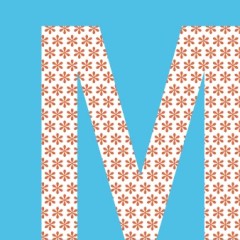
Cruising with s/v "Dream Chaser"....and still chasing the dream....since 2004.
Sharing the love we have for this lifestyle with stories full of fun and adventure.
16 January 2024
01 January 2019 | Little Harbor, Peter Island BVI
06 October 2017 | Dream Chaser in Hurricane Storage
12 February 2017 | The Highlands of Barbuda
12 February 2017 | Mangroves of Codrington Lagoon, Barbuda
12 February 2017 | Mangroves of Codrington Lagoon, Barbuda
12 February 2017 | Highlands of Barbuda
09 February 2017 | Cocoa Beach, Barbuda
09 February 2017 | Cocoa Beach, Barbuda
09 February 2017 | Codrington, Barbuda
07 February 2017 | Cocoa Point Beach and Anchorage, Barbuda
07 February 2017 | Cocoa Point Anchorage, Barbuda
07 February 2017 | Cocoa Beach Anchorage, Barbuda
04 February 2017 | In Codrington at Byron's Cafe, Barbuda
04 February 2017 | Barbuda's South Coast
04 February 2017 | Condrington Waterfront
04 February 2017 | Cocoa Beach aka Diana, Princess of Wales, Beach, Barbuda
03 February 2017 | Near Cocoa Point, Barbuda
02 February 2017 | Coral Beach, Barbuda
02 February 2017 | At Uncle Roddy's
Bonaire in the ABC Islands to Isla Margarita, Venezuela
13 February 2007 | Anchorage in Isla Margarita, Venezuela
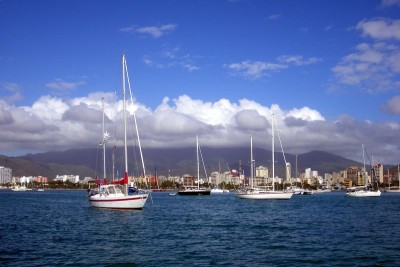
It has been a while since we have updated everyone as to our whereabouts. No, we haven't spent any more time in any Venezuelan clinics or hospitals. Thank goodness!
New Years eve was celebrated in Kralendijk, Bonaire in the southern Caribbean. Bonaire is part of the ABC islands, which include Aruba, Bonaire and Curacao. The week leading up to New Years and including the eve of, there were spectacular fireworks, but on a small scale. There were no government-sponsored celebrations or events, but every evening the local townsfolk would come down to the waterfront shoreline and shoot off their own fireworks displays. They ranged from small firecrackers to M-80s (or bigger) to gigantic displays. Children of all ages would participate in lighting these hand held firecrackers. We don't know the details but the people of Kralendijk have a contest to see who can have the longest string of firecrackers go off in succession. Sections of streets would be blocked off and once they start expoding, it is nonstop, continuous, extremely loud firecrackers, going off one after another, for as long as 45 minutes! They seemed to go on forever! They must go through millions upon millions of firecrackers. We went to shore once after they were done and there was literally a foot deep of firecracker papers in the street and the town people would clean the mess up with shovels. We saw empty wooden crates lying around that contained the firecrackers that were labeled "1,000,000 pieces". That's a whole lotta firecrackers!
Since Bonaire is a marine park and known for the spectacular diving we did a little bit of scuba diving ourselves. We could dive right from the boat since "Dream Chaser" was moored on the edge of the reefs. We also got a chance to try out our new scuba compressor so we can now fill our own tanks with air. We celebrated the holidays with other cruising friends new and old, and celebrated Lucia's fourth birthday on New Years Day. One day we went bike riding, and on another rented a car and did our own island land tour. On our land tour we discovered that the northern half of the island is very dry and covered with cactus and low scrub, and in the southern portion it is covered in mangroves, wetlands and salt flats where the pink flamingos wander around. We also saw pairs of Yellow Shouldered parrots flitting around and wild donkeys roaming the desert areas.
Although much of December had been relatively calm, the winds really picked up by the end of the month. These winds, known as the "Christmas Winds", were already blowing at points west of the ABC's at a good, continuous 25-30 knots. This built the seas up to 15 feet, just where we wanted to head. So, with no significant relief in sight until spring, we decided to postpone our trip going west for the time being. Columbia and Panama were not in the cards for us this cruising season. In order to go west with less wind you should travel before November 15 or after late March or April and we got a late start with the accident at Angel Falls. It is possible to get a weather window to go west, but it is rare and we didn't want to remain in the ABC's possibly waiting for many months. We have decided to go back east/north and sail the Virgins Islands, the Leewards and the Windward Islands for now. Our challenge at this point is how to head back east comfortably against the ever-blowing north easterly and easterly trade winds. Our destination is St. Thomas, which is roughly 475 miles or 3 � days at sea.
From Bonaire you can either head north into the wind and the seas for 500 miles straight or you can island hop back going east and then make a long passage north from somewhere further east. Because we could never get a good angle to head north we decided to head back east island hopping to get a better departure point.
On January 8th at 2:00 AM we departed Bonaire and set sail to back to the Aves for the outer anchorage at Aves de Barlevento. The weather report was for lighter winds and calmer seas so we set out. But of course, no sail is ever perfect and on our way we ran into significant squalls with 30-knot winds before sun-up. Since we were going into the easterly trade winds, we had to tack (zigzag) our way to keep an angle on the wind and the sails full. This added a lot of additional miles to our trip and we finally arrived the next evening at 6:30 PM. We dropped the hook in an outer anchorage specifically because it was easy to get into with little light left in the day. We knew that the reefs did not propose a problem in this anchorage.
After a few hours of sleep we left the anchorage at Barlavento the next morning at
2:30 AM for Cayo de Aqua in the southwestern part of Los Roques. Los Roques is similar to the Bahamas with crystal clear, aqua blue water, lots of small islands to explore with good diving and snorkeling. There we spent 4 full mornings sanding and re-varnishing teak on the portside (left side) rub rails and toe rails of the boat since the anchorage was nice and calm. The job done by the boys in Puerta La Cruz was not a good one and only after 2 months the wood needed to be re-done. Then after just one week we got another weather window to keep heading east. At this point we had come 170 miles east from Bonaire but we still didn't have a good enough angle on the wind to sail north.
On this window we set sail from The Roques on January 18th in the morning for our 30-hour trip to Chimana Grande, which is an island just outside of Puerta La Cruz, Venezuela. The seas were relatively calm but there were squalls that we dodged and then by the last third of the trip the wind died and we had to motor sail the rest of the way. On the way we caught a small tuna and a nice mahi-mahi and also had a pod of about 20 dolphins swimming in our bow wave for 20 minutes. We took turns during the night on 3 hour shifts so we could each get some sleep.
Approaching Chimana Grande
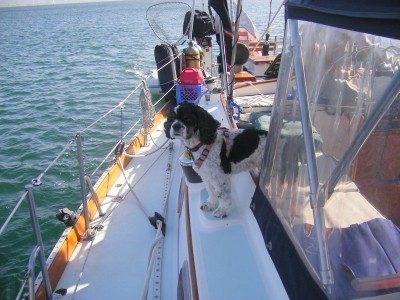
The next morning we left from Chimana Grande and motored the last 6 miles to Puerta La Cruz. We stayed at the same marina again and over the next three days we topped off on provisions and did some good 'house" cleaning on the boat while we had unlimited fresh water off the dock. Of course, the marina water supply stopped working after the 1st day and so our dirty boat stayed pretty dirty and salty. Oh well....
We departed the marina and headed back out to Chimana Grande to wait for weather again to head further east. The following morning for fun, we set out on a dinghy exploration. Not more than 75 feet from the boat we heard a loud "CRAACCKK" as the plastic floorboards in the dingy exploded splitting in two. At that point we figured we had better turn around incase there were any sharp edges that would put a hole in the dinghy. So again, that afternoon we returned to the marina. There we visited the "Dinghy Doctor" to see if it could be repaired or replaced. There were no floor replacements available and on close inspection the floor had many cracks that were just beginning and we declared the dinghy "terminal".
We hired Andres, one of the local taxi drivers, to take us to several of the
boating stores that carry new dinghies and we also checked out a few used dinghies for sale. In the cruising world, your dinghy is your car so careful decision making is required. We found a new one that fit the ticket but before our purchase we needed to get a hold of some more Venezuelan Bolivars (the local currency). We contacted "Charlie Alpha" on the VHF radio for the "meeting". Charlie Alpha, better known by his real name as Carlos, brought the money we needed in Venezuelan Bolivars to the marina. Shane met with him in his pickup, which had very dark windows, where the exchange of US dollars to B's was made. The exchange rate had increased drastically, almost 20% since we had been there in late November. This made the purchase even more economical in US Dollars. The next day while Andres was taking us back to the boating store, Autoboat, to make our purchase, Leo, another local cab driver, pulled up along side Andres' taxi and shouted to us. He said that he called the manager at Autoboat and arranged for us to get a 5% discount. Leo had heard though the grapevine that we were in need of a new dinghy and he was doing us a favor! We eventually became the proud owners of a 9-foot, rigid inflatable dingy by Caribe, which are made in Venezuela. The price was right and after everything was said and done, we probably paid half of what the same new dinghy would have cost in the states. With the dinghy on top of Andres' Ford Explorer we headed back to the marina. Next we had to find a home for the old dinghy. We donated it to Fund Amigos, which is a cruisers' sponsored program that raises money and provides free plastic surgery for children with facial disfigurations like cleft palate.
Later that afternoon on January 23rd, we left the marina (again) and set sail for Chimana Segunda only 7 miles away, to stage for our trip to Isla Margarita the next morning. Margarita is a fairly large island just north of the Venezuelan coastline. The entire next day was spent motor sailing to Margarita against the easterly trade winds and current. It took us quite a bit long than expected because of this so since we were running out of day light we stopped at an island just southwest of Margarita called Cubagua for the next two days.
Cubagua doesn't have much to offer except a very nice beach. It is an island void of any trees and it just has mainly cactus and old, dried up salt ponds. There are fishing shacks on it for the local fisherman and day trip catamarans bring tourists to come play on the beach. When we got anchored we noticed that the water was full of small, baby jellyfish with very long tentacles. Then the next morning the small jellyfish were nowhere to be seen but we now had huge jellyfish about a foot across or better surrounding our boat. That evening there was a pod of whales blowing their spouts not far from the anchorage.
Residents of Isla Coche

After two days at Cubagua we sailed the remaining 25 miles into the east wind and current to Margarita. This was our final destination before heading north to St. Thomas. The next weather window to go north was going to be in a couple of days so we took on 65 gallons of diesel fuel and 10 gallons of gas for a total of $22 US.
Margarita Fuel Barge
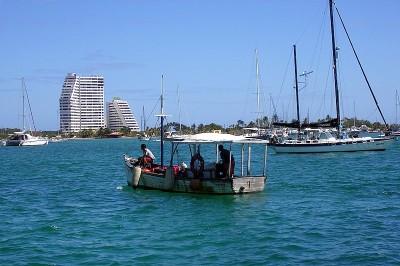
Fisherman & his son

We headed out on Tuesday afternoon, January 31st on what we thought was going to be a good weather window to head north to St. Thomas in the US Virgin Islands. Without going into further detail, we plain just didn't get there on that try. That is another story in itself to be written about soon!
We finally made it to St. Thomas on February 11. It took us 3 days at sea, about 74 hours and 475 miles. We are really glad to be here.
New Years eve was celebrated in Kralendijk, Bonaire in the southern Caribbean. Bonaire is part of the ABC islands, which include Aruba, Bonaire and Curacao. The week leading up to New Years and including the eve of, there were spectacular fireworks, but on a small scale. There were no government-sponsored celebrations or events, but every evening the local townsfolk would come down to the waterfront shoreline and shoot off their own fireworks displays. They ranged from small firecrackers to M-80s (or bigger) to gigantic displays. Children of all ages would participate in lighting these hand held firecrackers. We don't know the details but the people of Kralendijk have a contest to see who can have the longest string of firecrackers go off in succession. Sections of streets would be blocked off and once they start expoding, it is nonstop, continuous, extremely loud firecrackers, going off one after another, for as long as 45 minutes! They seemed to go on forever! They must go through millions upon millions of firecrackers. We went to shore once after they were done and there was literally a foot deep of firecracker papers in the street and the town people would clean the mess up with shovels. We saw empty wooden crates lying around that contained the firecrackers that were labeled "1,000,000 pieces". That's a whole lotta firecrackers!
Since Bonaire is a marine park and known for the spectacular diving we did a little bit of scuba diving ourselves. We could dive right from the boat since "Dream Chaser" was moored on the edge of the reefs. We also got a chance to try out our new scuba compressor so we can now fill our own tanks with air. We celebrated the holidays with other cruising friends new and old, and celebrated Lucia's fourth birthday on New Years Day. One day we went bike riding, and on another rented a car and did our own island land tour. On our land tour we discovered that the northern half of the island is very dry and covered with cactus and low scrub, and in the southern portion it is covered in mangroves, wetlands and salt flats where the pink flamingos wander around. We also saw pairs of Yellow Shouldered parrots flitting around and wild donkeys roaming the desert areas.
Although much of December had been relatively calm, the winds really picked up by the end of the month. These winds, known as the "Christmas Winds", were already blowing at points west of the ABC's at a good, continuous 25-30 knots. This built the seas up to 15 feet, just where we wanted to head. So, with no significant relief in sight until spring, we decided to postpone our trip going west for the time being. Columbia and Panama were not in the cards for us this cruising season. In order to go west with less wind you should travel before November 15 or after late March or April and we got a late start with the accident at Angel Falls. It is possible to get a weather window to go west, but it is rare and we didn't want to remain in the ABC's possibly waiting for many months. We have decided to go back east/north and sail the Virgins Islands, the Leewards and the Windward Islands for now. Our challenge at this point is how to head back east comfortably against the ever-blowing north easterly and easterly trade winds. Our destination is St. Thomas, which is roughly 475 miles or 3 � days at sea.
From Bonaire you can either head north into the wind and the seas for 500 miles straight or you can island hop back going east and then make a long passage north from somewhere further east. Because we could never get a good angle to head north we decided to head back east island hopping to get a better departure point.
On January 8th at 2:00 AM we departed Bonaire and set sail to back to the Aves for the outer anchorage at Aves de Barlevento. The weather report was for lighter winds and calmer seas so we set out. But of course, no sail is ever perfect and on our way we ran into significant squalls with 30-knot winds before sun-up. Since we were going into the easterly trade winds, we had to tack (zigzag) our way to keep an angle on the wind and the sails full. This added a lot of additional miles to our trip and we finally arrived the next evening at 6:30 PM. We dropped the hook in an outer anchorage specifically because it was easy to get into with little light left in the day. We knew that the reefs did not propose a problem in this anchorage.
After a few hours of sleep we left the anchorage at Barlavento the next morning at
2:30 AM for Cayo de Aqua in the southwestern part of Los Roques. Los Roques is similar to the Bahamas with crystal clear, aqua blue water, lots of small islands to explore with good diving and snorkeling. There we spent 4 full mornings sanding and re-varnishing teak on the portside (left side) rub rails and toe rails of the boat since the anchorage was nice and calm. The job done by the boys in Puerta La Cruz was not a good one and only after 2 months the wood needed to be re-done. Then after just one week we got another weather window to keep heading east. At this point we had come 170 miles east from Bonaire but we still didn't have a good enough angle on the wind to sail north.
On this window we set sail from The Roques on January 18th in the morning for our 30-hour trip to Chimana Grande, which is an island just outside of Puerta La Cruz, Venezuela. The seas were relatively calm but there were squalls that we dodged and then by the last third of the trip the wind died and we had to motor sail the rest of the way. On the way we caught a small tuna and a nice mahi-mahi and also had a pod of about 20 dolphins swimming in our bow wave for 20 minutes. We took turns during the night on 3 hour shifts so we could each get some sleep.
Approaching Chimana Grande

The next morning we left from Chimana Grande and motored the last 6 miles to Puerta La Cruz. We stayed at the same marina again and over the next three days we topped off on provisions and did some good 'house" cleaning on the boat while we had unlimited fresh water off the dock. Of course, the marina water supply stopped working after the 1st day and so our dirty boat stayed pretty dirty and salty. Oh well....
We departed the marina and headed back out to Chimana Grande to wait for weather again to head further east. The following morning for fun, we set out on a dinghy exploration. Not more than 75 feet from the boat we heard a loud "CRAACCKK" as the plastic floorboards in the dingy exploded splitting in two. At that point we figured we had better turn around incase there were any sharp edges that would put a hole in the dinghy. So again, that afternoon we returned to the marina. There we visited the "Dinghy Doctor" to see if it could be repaired or replaced. There were no floor replacements available and on close inspection the floor had many cracks that were just beginning and we declared the dinghy "terminal".
We hired Andres, one of the local taxi drivers, to take us to several of the
boating stores that carry new dinghies and we also checked out a few used dinghies for sale. In the cruising world, your dinghy is your car so careful decision making is required. We found a new one that fit the ticket but before our purchase we needed to get a hold of some more Venezuelan Bolivars (the local currency). We contacted "Charlie Alpha" on the VHF radio for the "meeting". Charlie Alpha, better known by his real name as Carlos, brought the money we needed in Venezuelan Bolivars to the marina. Shane met with him in his pickup, which had very dark windows, where the exchange of US dollars to B's was made. The exchange rate had increased drastically, almost 20% since we had been there in late November. This made the purchase even more economical in US Dollars. The next day while Andres was taking us back to the boating store, Autoboat, to make our purchase, Leo, another local cab driver, pulled up along side Andres' taxi and shouted to us. He said that he called the manager at Autoboat and arranged for us to get a 5% discount. Leo had heard though the grapevine that we were in need of a new dinghy and he was doing us a favor! We eventually became the proud owners of a 9-foot, rigid inflatable dingy by Caribe, which are made in Venezuela. The price was right and after everything was said and done, we probably paid half of what the same new dinghy would have cost in the states. With the dinghy on top of Andres' Ford Explorer we headed back to the marina. Next we had to find a home for the old dinghy. We donated it to Fund Amigos, which is a cruisers' sponsored program that raises money and provides free plastic surgery for children with facial disfigurations like cleft palate.
Later that afternoon on January 23rd, we left the marina (again) and set sail for Chimana Segunda only 7 miles away, to stage for our trip to Isla Margarita the next morning. Margarita is a fairly large island just north of the Venezuelan coastline. The entire next day was spent motor sailing to Margarita against the easterly trade winds and current. It took us quite a bit long than expected because of this so since we were running out of day light we stopped at an island just southwest of Margarita called Cubagua for the next two days.
Cubagua doesn't have much to offer except a very nice beach. It is an island void of any trees and it just has mainly cactus and old, dried up salt ponds. There are fishing shacks on it for the local fisherman and day trip catamarans bring tourists to come play on the beach. When we got anchored we noticed that the water was full of small, baby jellyfish with very long tentacles. Then the next morning the small jellyfish were nowhere to be seen but we now had huge jellyfish about a foot across or better surrounding our boat. That evening there was a pod of whales blowing their spouts not far from the anchorage.
Residents of Isla Coche

After two days at Cubagua we sailed the remaining 25 miles into the east wind and current to Margarita. This was our final destination before heading north to St. Thomas. The next weather window to go north was going to be in a couple of days so we took on 65 gallons of diesel fuel and 10 gallons of gas for a total of $22 US.
Margarita Fuel Barge

Fisherman & his son

We headed out on Tuesday afternoon, January 31st on what we thought was going to be a good weather window to head north to St. Thomas in the US Virgin Islands. Without going into further detail, we plain just didn't get there on that try. That is another story in itself to be written about soon!
We finally made it to St. Thomas on February 11. It took us 3 days at sea, about 74 hours and 475 miles. We are really glad to be here.
Comments
| Vessel Name: | Dream Chaser |
| Vessel Make/Model: | 2014 Fontaine Pajot Helia 44 (FKA a 1981 Bristol 45.5) |
| Hailing Port: | Minneapolis, Minnesota |
| Crew: | Shane, Sara & Lucia |
| About: | |
| Extra: |
Gallery not available
Dream Chaser's Crew
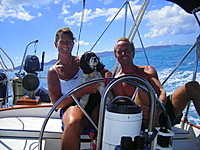
Who: Shane, Sara & Lucia
Port: Minneapolis, Minnesota
